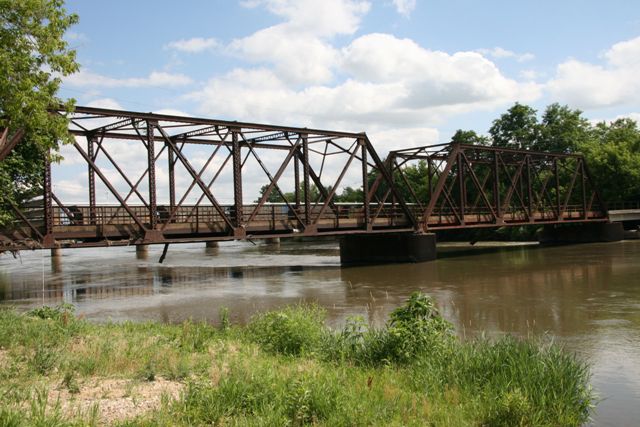We Recommend:
Bach Steel - Experts at historic truss bridge restoration.
BridgeHunter.com Phase 1 is released to the public! - Visit Now
Blackhawk Road Bridge
Race Street Bridge

Primary Photographer(s): Nathan Holth and Rick McOmber
Bridge Documented: July 2, 2009
Ottumwa: Wapello County, Iowa: United States
1974
100.0 Feet (30.5 Meters)
252.0 Feet (76.8 Meters)
18.7 Feet (5.7 Meters)
2 Main Span(s) and 2 Approach Span(s)
9320

View Information About HSR Ratings
Bridge Documentation
This bridge no longer exists!
This historic bridge was demolished in 2011!
This bridge at first glance at the key and technical facts appears to be a traditional truss bridge. However upon closer inspection it appears that this must be a bridge with an interesting history. The bridge has been closed to all traffic. The bridge consists of two six panel Pratt trusses with a concrete approach span at the western end. There are sidewalk cantilevers that do not contain a sidewalk. The bridge crosses over an east channel of the Des Moines River to an island in the river. According to maps, Black Hawk Road ends on the island, and then starts up again on the west bank of the Des Moines River. Because of this, and given that there does not appear to be a whole lot on the island (if anything) and although there may have been something on the island in the past, it still seems likely that there was likely a second bridge over the western channel of the river as well giving the bridge a true functional purpose, although today there is nothing. Another interesting part of the bridge is the pier holding the western truss and the approach span. This pier has suffered from a large amount of rotation, and as such it has a very easily noticeable appearance tipping over. Equally interesting is the quick / short-term fix that was applied which was to apparently lift the bridge up and place metal plates under the bridge on the pier at one end to lift the end of the bridge which had been lowered by the rotation. It is unclear if this was done all at once as a single project, or if it was done more than once, which would be particularly possible if the rotation occurred very slowly over a period of time. There are three holes cut in the sidewalk cantilever at this corner of the bridge, which may have been done to aid in the lifting of the bridge, although this hypothesis is purely speculative with only a site inspection of the bridge as a source of information. Also unusual is the western concrete approach span on the bridge. This concrete span appears to be newer than the truss spans. Under this approach span is what appears to a concrete abutment surrounded by water. It seems likely that a flood (of which Iowa and the Des Moines River has had its share of) washed out the dirt behind this original western abutment. Afterwards, rather that build up the dirt behind the original abutment, a new abutment was constructed at the newly formed edge of the river's channel, and the current approach span was erected in place of the original shorter approach span. Finally, another unusual feature observed at the bridge which is what appears to be the halves of caissons (lally columns) next to the (original) abutments at each original ends of the bridge on the upstream side. These might be remnants from a former bridge.
This bridge was demolished in 2011. While the substructure was failing, this is no excuse to destroy the superstructure. The trusses could have been lifted off, the substructure demolished and rebuilt, and the trusses placed back upon on the new substructure. If funding did not allow for construction of a new substructure, the trusses could have been placed on the ground at a non-functional exhibit, or even placed into storage for future preservation. Demolishing the trusses was wasteful and shortsighted.
![]()
Photo Galleries and Videos: Blackhawk Road Bridge
Bridge Photo-Documentation
Original / Full Size PhotosA collection of overview and detail photos. This gallery offers photos in the highest available resolution and file size in a touch-friendly popup viewer.
Alternatively, Browse Without Using Viewer
![]()
Bridge Photo-Documentation
Mobile Optimized PhotosA collection of overview and detail photos. This gallery features data-friendly, fast-loading photos in a touch-friendly popup viewer.
Alternatively, Browse Without Using Viewer
![]()
Maps and Links: Blackhawk Road Bridge
This historic bridge has been demolished. This map is shown for reference purposes only.
Coordinates (Latitude, Longitude):
Search For Additional Bridge Listings:
Bridgehunter.com: View listed bridges within 0.5 miles (0.8 kilometers) of this bridge.
Bridgehunter.com: View listed bridges within 10 miles (16 kilometers) of this bridge.
Additional Maps:
Google Streetview (If Available)
GeoHack (Additional Links and Coordinates)
Apple Maps (Via DuckDuckGo Search)
Apple Maps (Apple devices only)
Android: Open Location In Your Map or GPS App
Flickr Gallery (Find Nearby Photos)
Wikimedia Commons (Find Nearby Photos)
Directions Via Sygic For Android
Directions Via Sygic For iOS and Android Dolphin Browser
USGS National Map (United States Only)
Historical USGS Topo Maps (United States Only)
Historic Aerials (United States Only)
CalTopo Maps (United States Only)

